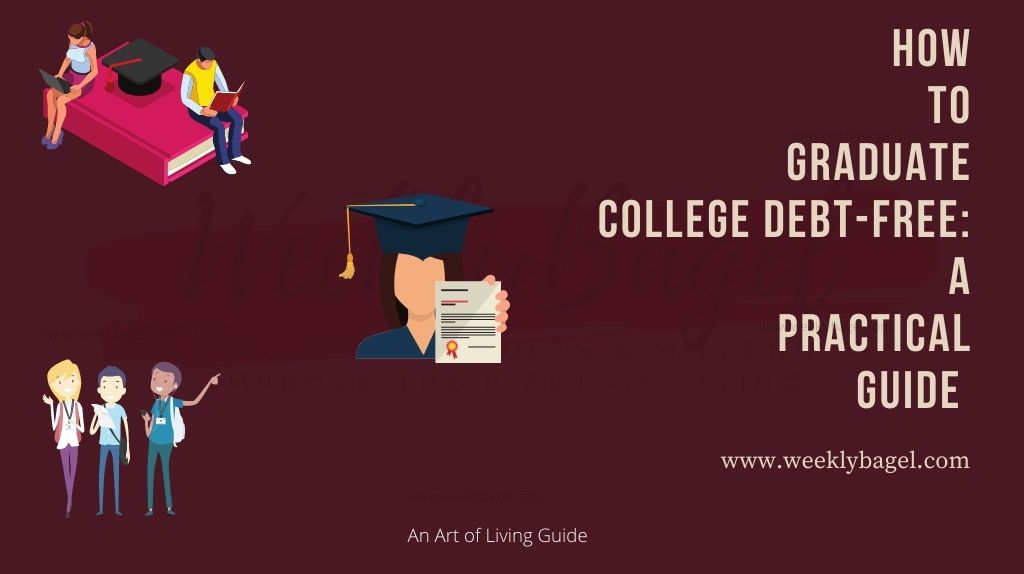
It is a new year. Some changes are often expected in ones lifestyle. These include plans to graduate college debt-free. Since you are here, I am going to assume you are planning on taking college classes this year. Or, you are currently taking some. If this is the case, you are probably one of the millions of American college students who are worried about graduating with a high college debt.
And, you have every right to be worried.
According to EducationData Organization, American student loan debt is growing faster than our American economy. The growth rate of this debt is 513% faster than our gross domestic product. Not only this fact, but also 44.7 million student borrowers owe an average of $37, 584 each. 94.8% of the student debtors borrowed for an undergraduate education. If 94.8% borrowed, that mean 9 out of every ten student or 18 out of every 20 students. You are more likely to belong to the 94.8% borrowers without a plan to help you graduate debt free.
That is why I am here, am I not?
I am here to show you how to graduate debt-free from college. Again, it is possible to graduate with zero debt. In Fall 2017, I graduated from San Antonio College with zero debt and an engineering degree. You can graduate with almost or no debt too. Just take your eyes off the Financial Student Aid (FASFA), and think about what I am about to tell you on this post. If you are patient enough, you can do it too.
Here we go:
How To Graduate Debt-Free From College
It is possible to graduate college debt free, despite high student loan debt after graduation. These are the practical ways you can use to graduate from college debt-free. They require great patience to work. Since you are here, you have got what it takes. Let’s jump in.
1. Opt In For Community Colleges
One consistent observation I have made about my fellow American students is that most students want to jump into a university, although most cannot afford one semester of a university education. After inquiring from thirty students of different universities, I found out half have misconceptions about community colleges. They believed community colleges cannot teach in this same level as universities.
And, this is not true. Let me explain.
A community college and a two-year university education is exactly the same. In fact, a community college education is more affordable, personalized and easy for students seeking a higher education. In a community college, there are about ten to fifteen students per class compared to the university large classes.
Besides, the tuition difference is huge. The tuition of three semesters in a university is enough to get you a practical two-year degree from a community college. For example: I paid +$7500 in the first semester of my senior year at University of Texas after I graduated from San Antonio college and transferred for my two-year Bachelor program. The $7500 was for four engineering classes. In San Antonio college, I paid $800 to $1200 for four classes in a semester.
Interesting, isn’t it?
When you go to a community college, you can afford to pay your own school fees out of your financial pocket. You can graduate college debt-free. Since community colleges offer only two-year degree programs, you can finish your two-year with a practical degree there. Then, transfer to a university for the remaining two years while working with the degree. It will reduce any potential student debt from the university significantly.
2. Get A Full-time Job While In College
A misconception some college freshman has about classes is taking college classes makes it hard to work. It is a bloody lie. Now, do not get wrong. There are some classes which can clash with a job schedule, but this can be avoided too. During class registration, you can get classes which will work well with a job schedule.
Sometimes, all your classes can fall into two days in a week. If you are lucky, they can be the same day schedule. It is rare for full-time classes though. So, this is what you do in order to graduate college debt-free.
First, take account of your daily time expenditure. You have twenty-four hours in a day. Out of those hours, you sleep about eight hours. Now, you have sixteen hours left. Out of the sixteen hours, your class schedules cannot exceed seven hours. There is an exception to this rule. Law and Medical-related fields require a huge time commitment. Here, I am talking about other full-time undergraduate levels.
Next, try to register all your classes in one section of the day or week. For example: you can register your classes in the evening (4pm to 9pm). Or, you can do morning (7am to 1pm). If the class registration is set up in such a way your required classes fall in one day or week, it allows you to work. If it is possible, register all the classes in one day. This will free six days of work; this is about 144 hours to work and study.
Six days of weekly work in three months are enough to help you pay down any accrued community college debt, are they not?
Since you cannot work more than 40 hours a week as a full time worker in the United States of America, you have 104 hours to study and sleep. You have more than enough hours to earn money to pay for your classes. I did mine way.
3. Use Employer College Tuition Reimbursement
In the United States, some large corporations offer tuition reimbursement. If you are not working, you would not know about this job benefit. The beautiful thing about it is you do not have to be a full-time worker to get the reimbursement. Just submit your grades to the Human Resource department at the end of the semester. And, you will get your tuition back.
Isn’t that sweet, dear reader?
As a result of this kind gesture from multi-billion dollar corporations, you can graduate college debt-free. This is exactly why you need to work, while taking college classes. Some companies can reimburse your tuition up to 100%. This means you get back the thousands of dollars, which you worked your ass off to pay in tuition. If you ask me, working in college is a great investment since it minimizes your student debt!
You can read How Your Employer Tuition Reimbursement Could Squash Your Debts. I elaborated more about employer college tuition reimbursement on the article. It is a great read.
4. Invest In College Used Books
I was able to graduate from college debt-free, because I invested in used books. You agree with me that some college textbooks can cost up to $400. Now, imagine you have to buy four at such a price. This is why students opt for student loans, since it is difficulty to pay such academic expenses out of pocket.
Personally, it does not make sense to me to pay $400 for a textbook in a digital age. In my first year of college and the United States, $400 can put food in my family’s table for a month. That was why I was not about to waste unnecessary money for books. Here are what I did to minimize textbook expenses.
At the end of every semester, I would go into the classes of the professors I would be taking the next semester; then, I would buy the textbooks from the students for one fourth of what they paid for it. Most students were happy to sell their textbooks after the semester is over. Usually, I met the professors to make sure they will use the same textbooks next semester. If yes, then I bought the textbook. You can try it too.
If you are frugal like me, you would not mind trying it. This is because you can get some ridiculously low and barely used textbooks from the students. Do not thank me yet. I forgot to tell you some students will curse you out for insulting their intelligence. Please bear that in mind, before embarking on the task at hand.
In case you do not like to put yourself out there, there are used book stores in your city. You can google and go ask them for your required textbooks. Amazon is a great place too. Most of the textbooks I got from my second degree were from Amazon. The new ones sold for a few hundreds, but I never paid more than $100 for each. Therefore, try to surf amazon before resorting to going on campus after the final exams to buy textbooks from your students.
5. Apply For College Grants & Scholarships
Try to inquire about grants and scholarships. College financial aid offices have information on available grants and scholarships. Also, go on your school’s website to search for them. Usually, grants and scholarships are posted every year. Do not neglect their importance. A scholarship is the college student’s salvation army.
Moreover, a scholarship helps to reduce your college expenses. I once got a T-STEM scholarship which paid for three semesters in college. The best part of it was that I still had some changes from the scholarship, after I paid for tuition and textbooks. It was an effective financial means of lowering any academic expenses and college debt I had then.
Finally, there are hundreds of other legitimate organizations offering scholarships to college students. Check out College Rank for their lists of academic websites and organizations offering scholarships. Try to apply about ten scholarships and grants per semester. Your chances of getting one increases your chances of reducing any college debt before your graduation.
6. Foster-care Waiver
Some states in the United States of America offer college tuition waiver for kids and adults who were under foster care. This tuition waiver is for state supported colleges or universities. If you were under a foster care or currently under one, you may want to check this at the financial aid office of your school. This is because it reduces your academic expenses significantly to almost nothing. In fact, it is the surest way of graduating debt-free from a college.
There is a catch though. You have to be a foster kid, or had been one.
In addition, you have to qualify for the tuition waver as a foster kid. If you are in the State of Texas, check out our State College Tuition Waiver requirement from the Texas Department of Family and Protective Service. Do not worry for missing out, because you are in another state. As of 2020, 38 American states offer college tuition waiver for people who were under DFPS conservatorship. This is why I recommend your college or university’s financial aid office to help you determine whether you are qualified.
Please make use of the opportunity. If you are qualified to receive this, you will not be charged tuition for attending state-sponsored colleges or universities. Moreover, there is no age limit for people who qualified. Any qualified applicant will not regret the decision.
7. Use Student Loan Forgiveness Programs
There are student loan forgiveness programs, which can reduce your student debt to zero. So, who qualifies for these student loan forgiveness programs?
Undergraduate students who are in some public service or health-related programs can graduate college without debt through these loan forgiveness programs. Some student loan forgiveness apply to graduate debt too. The loan forgiveness is classified based on major.
Some examples include:
- Undergraduate Scholarships and Graduate Loan Forgiveness For Nurses
- Loan Forgiveness For Doctors
- Loan Forgiveness For Public Service workers
One thing about these programs, is they can pay your student debt while you are in school. Or, you may be required to work in a town or city in the US with high demand for graduates in your field after graduation for a year or two. During your service time, the program will pay off your student debt.
8. Apply For Total and Permanent Disability (TPD) Discharge
If you are a disabled student with total and permanent disability, you may qualify to get your student debt discharged after college. This is as long you are able to provide medical and legal documentations showing your disability affect your ability to earn a full time salary.
Additionally, you can graduate debt free if you could show your physical and mental impairment could be expected to result in death during a substantial gainful activity. You can read more about this on Biden Cancels Student Debt For Disabled People: How To Get Yours.
9. Get Out Of Paying Student Loan Legally
You can legally get out of paying back student loans. One of the ways to get a debt free degree is to join the US military service. Or even better work for them.
It is one of the numerous education benefits of joining the military. I mean going to college debt free. You are supported in a way, which sees you graduating college with no debt at all. All your college student debt problems are handled, while all you have to do is focus on studying.
Given the average student loan debt after graduation, this is not a bad idea at all. Also, I want to use this opportunity to see not every person serving in the US military sees combat. There are many areas to contribute as well.
These include:
- Research and Development
- Engineering
- Health sector
- Public administration
- Logistics
- Linguistics
There are many other areas where your services. The military is surest way to get rid of debt. Be sure to get all the information, before joining though. It will surely help you in your journey as a debt free graduate.
How Common Is It To Graduate Debt Free
What percentage of college students graduate debt-free?
It is quite common to graduate debt free. According to a research work by the Association Of Public Land-Grant Universities, 42% of students graduate debt free from four-year universities. This translates to 4 out of 10 students who graduate. It shows it is realistic to graduate college debt free, since there are students doing it.
On the whole, you could be a part of this percentage by following the practical advice here. It will help your journey immensely. This is because it helped me graduate college without debt.
For the most part, I have covered the necessary guide which will help you graduate debt-free from college. It is left for you to work on them. These are how I graduate debt-free from college. You can do it too. It is a new year. Let us stand firm in our decision to graduate with minimal or no debt, shall we?
Resources:
Bustamante, Jaleesa. “Student Loan Debt Statistics [2020]: Average + Total Debt.” EducationData, 30 Dec. 2020, educationdata.org/student-loan-debt-statistics.
“Texas Department of Family and Protective Services (DFPS).” DFPS, www.dfps.state.tx.us/Child_Protection/Youth_and_Young_Adults/Education/state_college_tuition_waiver.asp.
“The Best Scholarship Websites to Find Your Funding.” College Rank, 5 Nov. 2019, www.collegerank.net/best-scholarship-websites/.
What is the typical debt load for graduates of four-year public universities?. APLU. (2023, March 1). https://www.aplu.org/our-work/4-policy-and-advocacy/publicuvalues/student-debt/#:~:text=More%20than%20four%20in%20ten,degree%20at%20a%20public%20university.




 How To Deposit A Check On Chime App
How To Deposit A Check On Chime App